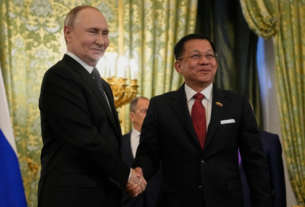Inflation in the eurozone eased to 2.4% in February, down from 2.5% in January, marking another step toward the European Central Bank’s (ECB) 2% target. The decline has reinforced expectations that the ECB will cut interest rates in the coming months.
“The ECB has the room it needs to act,” said an economist tracking inflation trends. The central bank has been considering rate cuts to stimulate economic activity as growth remains sluggish.
Recent data shows energy prices were a key factor in the slowdown. Energy inflation fell to 0.2% in February from 1.9% in January, reducing pressure on overall consumer prices.
Services inflation, a major driver in recent months, also showed a slight drop. It eased to 3.7% from 3.9%, reflecting a moderation in price increases in transportation, hospitality, and other service sectors.
Food, alcohol, and tobacco prices moved in the opposite direction. Inflation in this category rose to 2.7% from 2.3%, showing that some consumer goods remain costly despite overall disinflation.
Non-energy industrial goods inflation stayed relatively stable. Prices rose 0.6% in February, up slightly from 0.5% in January, indicating limited price pressures in manufacturing and retail sectors.
“The economy still faces significant challenges,” said a financial strategist. The eurozone stagnated in late 2024, and recent reports suggest little improvement in early 2025.
Businesses and consumers have been affected by high borrowing costs. The ECB raised interest rates aggressively in 2022 and 2023 to fight inflation, but as price pressures ease, the focus is shifting toward economic recovery.
External risks remain a concern. Geopolitical tensions, potential new trade restrictions, and uncertainty over global demand continue to impact economic sentiment.
“The ECB needs to be cautious,” warned a market analyst. Cutting rates too soon could reignite inflation, while waiting too long could further weaken growth.
Investors are closely watching the ECB’s next steps. The central bank is expected to lower interest rates by 25 basis points, which could help businesses and households struggling with high borrowing costs.
Lower rates would reduce loan expenses for companies, encouraging investment. Households could also benefit as mortgage and credit costs decline.
Labor market conditions remain a factor in the ECB’s decision-making. Wage growth has slowed, but some sectors continue to see upward pressure on salaries, which could keep services inflation elevated.
The ECB has emphasized a data-driven approach. Policymakers are reviewing inflation trends, economic growth indicators, and financial conditions before making a final decision.
A rate cut would align the ECB with other major central banks. The U.S. Federal Reserve and the Bank of England have also signaled potential rate reductions later this year.
Some experts believe the ECB will wait until mid-2025 before making a move. Concerns about inflation persistence and financial stability could delay immediate action.
Financial markets have already priced in a rate cut. Stocks and bonds have responded positively to expectations that monetary policy will soon become more accommodative.
The ECB’s next meeting will be a key moment for markets. If inflation continues to fall and economic data weakens further, a rate cut could come sooner than expected.
Consumers are feeling the effects of slowing inflation. Grocery prices have stabilized, energy costs have declined, and overall purchasing power has improved slightly.
Business leaders are pushing for policy support. Many argue that high interest rates have constrained growth and that lower borrowing costs are necessary to boost economic activity.
Policymakers remain divided on the timing of a rate cut. Some argue that inflation is still too high, while others see an opportunity to support the economy without risking price instability.
The next few months will be crucial. Inflation trends, economic performance, and global developments will all play a role in shaping the ECB’s decision.
Europe’s economic outlook remains uncertain. While inflation is easing, slow growth and external risks continue to challenge policymakers in their efforts to strike the right balance.




